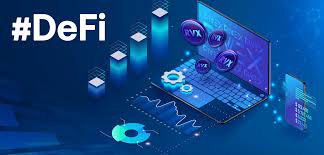In the ever-evolving world of personal finance and investment, a disruptive innovation is quietly shifting the rules of the game: Decentralized Finance, or DeFi. For retail investors new to the space, DeFi might sound like yet another tech buzzword, but its implications are far-reaching. In essence, DeFi refers to a set of blockchain-based applications and protocols that aim to replicate—and often improve upon—traditional financial services like lending, borrowing, trading, and saving, but without intermediaries like banks or brokerages.
DeFi is not just a trend among crypto enthusiasts—it has grown into a multi-billion-dollar ecosystem. As of early 2025, the total value locked (TVL) in DeFi protocols globally sits around $65 billion, a notable rebound from the crypto winter of 2022. Platforms such as Aave, Uniswap, and Compound are leading the way, offering peer-to-peer financial services governed by smart contracts rather than corporate entities.
Cosa rende diversa la DeFi?
The core innovation of DeFi lies in decentralization. Instead of needing to trust a central bank, traditional institution, or even a fintech company, users interact directly with software protocols. These protocols operate on blockchains like Ethereum, Solana, or newer Layer 2 solutions. They’re open-source, global, and typically non-custodial, meaning you always retain control over your assets.
In practice, this means you could lend your stablecoins like USDC or DAI and earn interest that’s automatically paid out via smart contracts. Or you could provide liquidity to decentralized exchanges (DEXs) and earn trading fees. With traditional banks in the Eurozone offering savings interest rates still below 2%, DeFi protocols often promise yields of 4–10%, although with far more risk.
I rischi dietro le ricompense
Of course, with innovation comes volatility. DeFi isn’t without its dark corners. Hacks, protocol failures, and smart contract bugs have led to significant losses. In 2022 alone, over $ 3 billion was lost to DeFi-related exploits globally. Regulation also remains a gray area, particularly in Europe, where new MiCA rules are still being fully interpreted and implemented in the DeFi context.
Another major risk for beginners is over-leverage. Many DeFi platforms allow users to borrow assets against collateral—sometimes in a looped fashion that multiplies gains but also magnifies losses. Without sufficient understanding, newcomers can easily get liquidated, losing their principal in volatile market conditions.
Accessibilità: Un'arma a doppio taglio
What makes DeFi both revolutionary and risky is its accessibility. Anyone with an internet connection and a crypto wallet (like MetaMask or Trust Wallet) can access DeFi apps. There’s no need for credit checks, paperwork, or even a traditional bank account. But this openness also means there’s little to no consumer protection if things go wrong. Unlike with regulated investment funds, there’s no recourse to authorities if a protocol fails or is hacked.
Tuttavia, per chi è curioso dal punto di vista finanziario, la DeFi offre un'incredibile opportunità formativa. L'esplorazione della DeFi costringe a capire come si genera il rendimento, cosa significa accantonamento di liquidità o come i rapporti di garanzia influiscono sul prestito. Questo approccio di apprendimento attivo spesso porta a una migliore alfabetizzazione finanziaria, soprattutto rispetto all'utilizzo passivo dei servizi bancari.
La DeFi diventerà un fenomeno di massa?
For DeFi to move beyond early adopters and reach everyday users, a few things need to happen: user interfaces must become more intuitive, security must improve, and regulators must provide clear frameworks. We’re already seeing steps in that direction with the rise of “CeDeFi” (Centralized-DeFi hybrids), where platforms like Coinbase and Binance offer DeFi-like yields in a more user-friendly and custodial environment.
Moreover, traditional finance (TradFi) isn’t ignoring the trend. Asset managers and banks are exploring tokenized assets, on-chain bond issuance, and even running nodes on Ethereum. This convergence hints that DeFi might not remain separate from mainstream finance—but could become its programmable backbone.
Perché è importante per i nuovi investitori
If you’re starting your financial journey, DeFi may not be the first place to allocate your funds. But it’s worth watching—and experimenting with small, calculated amounts. Learning how decentralized systems work could become as essential as understanding how banks operate today. Just like online banking revolutionized finance in the 2000s, DeFi could be the next chapter.
Even a €100 test run on a DeFi protocol can teach you more about markets, risk, and blockchain than hours of theory. And with the financial system evolving fast, being ahead of the curve—carefully and informed—can become a real asset.
Navigare con saggezza nella DeFi
Start slow. Use stablecoins. Stick to audited protocols with large user bases. Never invest money you can’t afford to lose. And always, always read the documentation. DeFi isn’t about gambling—it’s about engaging with finance in a radically transparent, programmable, and participatory way.
In a world where financial empowerment often feels out of reach, DeFi opens the door to a system built on code, not trust. And for a generation raised on apps and autonomy, that’s a powerful proposition.

